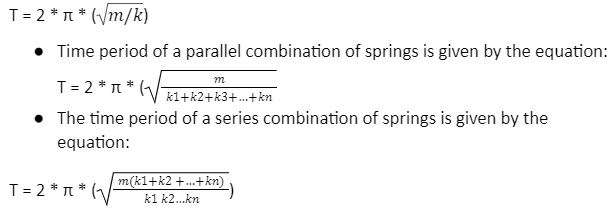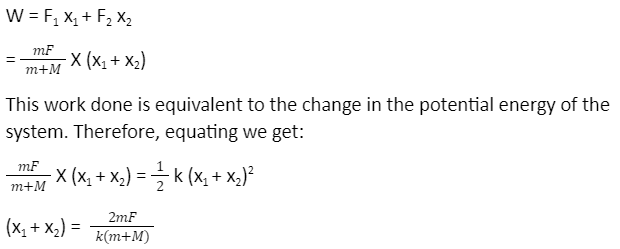What do you understand about spring?
Spring is basically an object that has the capacity to deform itself and then restore to its original shape whenever the external forces are removed. A spring stores the elastic potential energy whenever it is compressed by straining the bonds between the atoms of an elastic material.
Time Period of a Spring
The time period is defined as the time required by the spring to complete one to and fro oscillation. Frequency is the opposite of the time period and is defined as the number of oscillations made in one second.
T = 1 / f
Different Arrangements of Spring Mass Systems
Two different arrangements of the spring-mass systems are possible. These are:
The parallel combination of the springs
In a parallel combination of the springs, the springs are connected in parallel with the mass. The displacement of each spring is the same, but the restoring forces are different.
The equivalent spring constants of a parallel combination are given by
k = k1 + k2 + k3 + … + kn
Series combination of the springs
In a series combination of the springs, the springs are connected in series with the mass. The displacement of each spring is different, but the restoring forces are the same.
The equivalent spring constants of a series combination are given by

Time Periods of Simple Spring as Well as Time Period of Different Combinations of Springs
The time period of a spring-mass system is given by the equation:

Factors that Affect the Time Period of a Spring Mass System
- It is clear from the formula of the time period that the time period of a spring-mass system is directly proportional to the square root of the mass.
- And it is inversely proportional to the square root of the spring constant of the spring.
- This means that a heavy object will have more time period as compared to a light object.
- The time period is free from the gravitational acceleration of the earth and the amplitude.
- A constant force also does not affect the time period of a simple spring-mass system.
What type of Motion Does a Spring Mass System have?
The spring-mass system performs simple harmonic motion. This system is an example of a vibrating system. When an external force is applied to the system, it starts vibrating to and fro, depicting a simple harmonic motion. The simple harmonic motion follows Hooke’s Law. This implies that the spring-mass system also obeys Hooke’s Law.
Expression for the Total Displacement of Springs in Two-Block Systems
The total work done by the forced F1 and F2 is

Conclusion
This article explains the spring that is used in the spring-mass system and its various combinations in detail. It explains from scratch the spring, its combinations along with its time period. It also tells about the dependency of the time period. We hope this article proves to be helpful.
 Profile
Profile Settings
Settings Refer your friends
Refer your friends Sign out
Sign out













